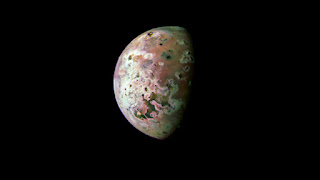Prometheus is famous for its consistent volcanic activity, thus earning it the moniker "Old Faithful of Io" among astrogeologists. An intricate image of the volcano in action has been released by NASA's Planetary Science Divisions.
The Volcanic Activity of Io
The Galilean moons, named in tribute to Galileo Galilei who first spotted them in 1610, are an intriguing array of celestial bodies. Scientists have been captivated for many years by Europa, Ganymede, and Callisto's three icy moons, which harbor potential life-supporting oceans. However, Io has recently taken center stage due to the intense volcanic activity on its surface and towering lava plumes reaching between 300 and 500 kilometers into space.
The image was captured during Juno's 53rd orbit of Jupiter, where JunoCam's scientists captured numerous images to study Jupiter's atmospheric lightning storms, polar cyclones, and filamentous clouds and jets. During this orbit, the spacecraft made its closest approach to Io, coming within 22,000 km of its lunar surface.
On its previous flyby on May 16, Juno captured photographs of the Volund area near Io's equator, renowned for its two active volcanoes displaying signs of eruptions. Distinctive "spots" on the landscape were identified by scientists as clear indications of outgassing associated with volcanic plumes.
The mission team capitalized on this close flyby to further scrutinize Io's surface and gather additional data on its numerous volcanic areas. Along with the images from JunoCam, the Italian Space Agency's Jovian InfraRed Auroral Mapper (JIRAM) and other scientific instruments collected comprehensive data. This latest collection of data is anticipated to enrich our understanding of the hundreds of volcanoes that consistently emit molten lava and sulfur gases across Io's lunar surface and its thin atmosphere.
Although NASA spacecraft (Galileo, New Horizons, and Juno) have been capturing Io's volcanic activities for the past three decades, scientists continue to be thrilled by new images of the moon's eruptions. Juno is set to make two more close flybys of Io, promising even more incredible images of the moon's wildly erupting surface, assuming all goes as planned. Unprocessed images are accessible on the JunoCam website for download and processing.
Source: Universe Today


Post a Comment